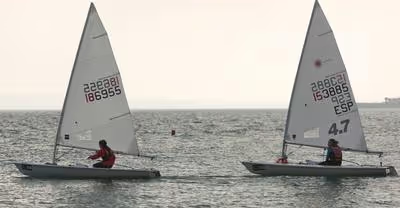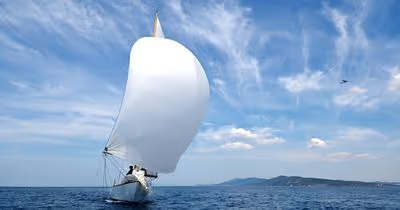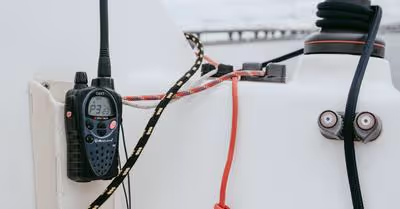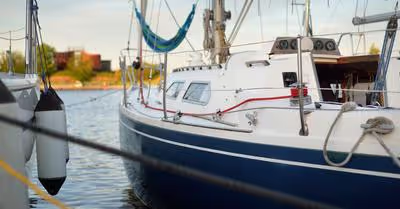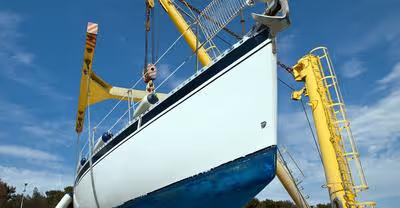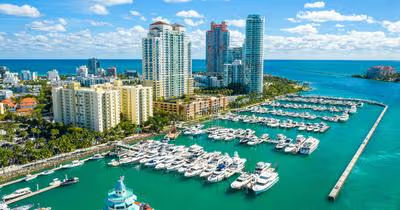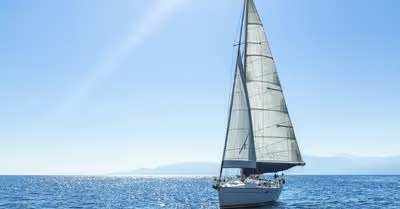Table of Contents
What Are Mooring Balls And Slips?
Mooring balls and slips are the two most common ways to tie a sailboat. You can think of a slip as a parking space for your sailboat. Compared to docks, slips are smaller and enclosed on three sides. This means that there is only one way to go in and out. Although the terms docks and slips are used interchangeably, dock refers to the actual structure of metal or wood.
Slips are large enough to hold only one vessel. They are arranged in rows so that boats can be parked side to side, much like cars in a parking lot.
As the name implies, Mooring balls are simply balls floating in the water, which can be used to tie up your sailboat. These balls are essentially buoys that have been anchored to the seabed. The most common method of installing a mooring ball is to tie it to a heavy concrete block and then drop the block into the water. The other end of the mooring ball has an eyelet, allowing sailors to tie their boats securely.
Both slips and mooring balls are safe and secure ways to tie your boat. Most sailors agree that mooring balls and slips are safer than leaving your sailboat anchored in a cove.
Benefits of Using A Slip
Slips are one of the most secure ways to tie up a boat. They keep your boat sheltered from most hazardous elements and are usually located deep in the marina. The boat is securely tied to pilings, hammered deep into the seafloor.
Slips are a comfortable and easy way to tie your boat for those who don’t worry about moving around the marina. They are connected to docks, which means you can walk out of your boat and into the shore. In addition, you can find most shore amenities such as repair shops, bathrooms, and other shops.
Sailors tied up in slips are often given access to utilities such as water, electricity, and internet connection. If you live aboard your boat, a slip is an excellent place to tie up as you will have access to all the utilities and amenities.
Slips are located in secure areas and are commonly located in coves and behind shoals to keep your precious boat protected from strong waves. If you are located on the coastline, tying up in a slip can make a huge difference as these areas are susceptible to harsh weather conditions.
Disadvantages of A Slip
One of the significant disadvantages of slips is getting crowded and becoming challenging to navigate. If you have a large boat and your slip is deep in the marina, you will have a tough time making sharp turns and making your way to your spot.
Moving through a marina becomes virtually impossible during the night. With boats tied close to each other, chances of collision are imminent. Most marinas do not have sufficient lighting, and the boat lights are usually not designed for navigating tight spaces.
Another issue with slips is that extra lighting and noise are discouraged since they are crowded and have many sailors living side by side. This means you cannot play loud music at night, and you will not be able to host parties unless you invite all your neighboring sailors, that is.
Another concern is if your boat has reverse gear. Many sailors struggle against currents and the wind to get their boats out of the slip because their vessels cannot be powered backward. They often have to get the boat pushed out by hand or using oars if far away from the pier.
The Costs of A Slip
Slips are pretty expensive as they offer many services and are more spacious and secure than mooring balls. If you have a lot of electrical equipment on board, you may need access to electrical power from the shore if you plan to spend time onboard.
Renting a slip can range from $10 to $250 per foot per year. On average, most marinas will charge around $50 per foot per year. This translates to about $750 - $1900 per year for an average sailboat. Many factors play a role in the rental, including your boat’s length, season, and location.
Slips are more commonplace than mooring balls, and renting a slip is quite simple. The best approach to acquiring a slip is to book it beforehand. This will ensure that you get a good location in the marina. Some marinas have a welcoming guest dock, which means the slips are available to anyone who pulls up to the marine on a first-come, first-serve basis. But experienced sailors advise against relying on guest docks unless you know the marina well.
On the other hand, most yacht clubs have a tedious process for letting you tie up in a slip. They are often picky about what types of boats go into their marina and have strict rules and regulations. Some yacht clubs only allow vessels from members of specific clubs. They are also quite expensive.
Marinas usually offer different rates for long and short-term tying up. Sailors who live on their boats usually pay a monthly rental to the marina, which is much cheaper than local house rentals. If you are looking to dock for a short term, you may have to pay the price similar to a hotel room.
Benefits of Using A Mooring Ball
The most significant advantage of mooring balls is that they are incredibly easy to use and tie up to. Most mooring balls will be located just beyond the slips or in a cove beside the marina. If you set the direction of your boat according to the mooring ball before coming in, you can tie up your boat quickly and easily.
Mooring balls are often considered similar to anchoring. If you are on board, you will not find different conditions compared to if you were anchored. However, there is an even slimmer chance of your boat drifting away.
Mooring balls are charged at a flat rate irrespective of the vessel size. You can tie up close to the dock but pay a significantly lower price. With that said, you should always cross-check for any size limitations before finalizing a mooring ball. The last thing you want is your tied boat drifting away and taking the anchor of the mooring ball with it.
Mooring balls are not expensive to install. All you need is a large concrete block tied up to a floating ball and an eyelet. For the cost of one slip, you can install more than ten mooring balls. The lower cost results in them being cheaper to rent for sailors.
Mooring balls keep your boat safe from thieves as the only way to access your vessel is via a dinghy or a boat. Mooring balls are placed away from the docks and are well spaced out, which means if you are planning to have a party overnight, you will not have to worry about loud music or any fancy lighting.
Disadvantages of A Mooring Ball
The main concern that most sailors have is access between the shore and the vessel. You will always need another boat to get off or on your boat while tied to the mooring ball.
Another issue with mooring balls is that most of them are located closer to the open waters. This means that your boat can turn and change direction during windy weather or if choppy water enters the marina. Boats that pass close by will also generate wake and cause unwarranted turbulence for your vessel.
Costs of A Mooring Ball
Numerous factors play a role in the rental price of the mooring ball. Location, season, and availability can affect pricing. But on average, a mooring ball will cost around $5 to $10 per night. Some larger marinas, such as premium yacht clubs, can charge much higher.
Recent Articles



